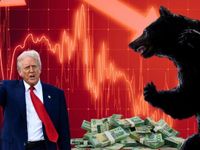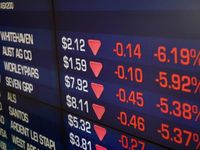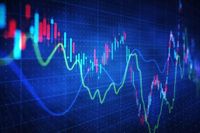The Australian stock market faced significant turbulence on April 7, 2025, as the S&P/ASX 200 index plummeted more than 6% shortly after opening, continuing a downward trend that has left investors anxious. The index ultimately closed down 324.5 points, marking a 4.23% decrease and ending the day at 7,343.3. This decline was not only a reflection of local market conditions but also indicative of broader global economic uncertainties, particularly those stemming from the United States.
Market analysts noted that the S&P/ASX 200's drop was particularly alarming as it was 4.42% from its session high and 2.43% from its low. In the broader S&P/ASX 300, the numbers were even more stark, with advancers lagging decliners by a staggering 19 to 271. This overwhelming trend points to a significant lack of confidence among investors, who are grappling with the implications of recent economic developments.
As the market reacted to these pressures, US futures indicated a further decline of 2.5% to 3%, adding to the sense of unease among Australian traders. The situation was exacerbated by the recent announcement of AUS ANZ Job Advertisements for March, which showed a modest increase of 0.4% month-on-month, contrasting sharply with a decline of 1.3% in February. This slight uptick in job advertisements did little to soothe the market's fears.
Chris Pedersen, CEO of Pedersen Asset Management, shared his insights on the current market chaos, suggesting that the recent drops were not unexpected. He stated, "I have been saying since November and December to lighten up on equities because of the chaos and uncertainties that will unfold come January from the US election." Pedersen's warning reflects a broader sentiment that many investors are feeling as they navigate this tumultuous economic landscape.
In his analysis, Pedersen pointed out that large market drops often occur following significant negative events, such as the recent 5% drop in New York on the preceding Friday. He noted that such declines often lead to margin calls, where investors are forced to sell off their assets to meet financial obligations. He warned, "This selling can trigger more selling as prices decline," indicating a potential downward spiral for the market.
The impact of tariffs, particularly those imposed during the Trump administration, remains a significant concern for investors. Pedersen emphasized that while these tariffs do not directly affect Australian trade with China, the ripple effects on global markets are profound. He stated, "Trump tariffs are a huge unknown. We cannot predict if he will pull back or by how much." This uncertainty contributes to the overall anxiety within the market.
As the day progressed, the market's reaction to these broader economic signals became increasingly evident. The trading day was characterized by a lack of demand, with many investors hesitant to make significant moves in such a volatile environment. Pedersen noted, "The demand-side's lack of desire – or inability – to stop the rot" highlights the severity of the situation.
Looking ahead, analysts are closely monitoring key economic indicators that could influence market sentiment. Upcoming reports include Westpac Consumer Sentiment for April and NAB Business Confidence for March, both of which are expected to provide further insights into the economic landscape. These reports will be critical in shaping investor expectations and could either alleviate some of the current fears or exacerbate them.
In the context of this turbulent market, the question remains: where should investors park their assets? Pedersen suggested that bond funds and cash trusts could be more stable options during this period of uncertainty. He expressed skepticism regarding gold as a safe haven, stating that even traditionally secure assets can behave like risk assets during significant market downturns.
As the Australian market grapples with these challenges, many investors are left wondering when the tide will turn. The potential for a relief rally exists, particularly if there are positive developments regarding tariffs or other economic policies. However, Pedersen cautioned that the current trajectory suggests a more prolonged period of volatility. He remarked, "If they start to run rampant, and spiral out of control, then a simple trade crisis becomes a credit crisis. Trust is lost in the system."
The historical context of market crashes, such as the 1987 crash and the Global Financial Crisis, serves as a reminder of the precarious nature of financial markets. Pedersen recalled how swift responses can mitigate the impacts of such downturns, but he remains cautious about the current situation. He noted that the causes of the 1987 crash were addressed quickly, leading to a relatively short-lived downturn, while the Australian market's recovery has often been slower due to different underlying issues.
In conclusion, the S&P/ASX 200's significant drop on April 7, 2025, is a stark reminder of the fragility of the current economic climate. As investors navigate these choppy waters, the interplay between domestic and international factors will be crucial in determining the future trajectory of the market. With uncertainty looming large, many are left to ponder whether stability is on the horizon or if more turbulence lies ahead.








